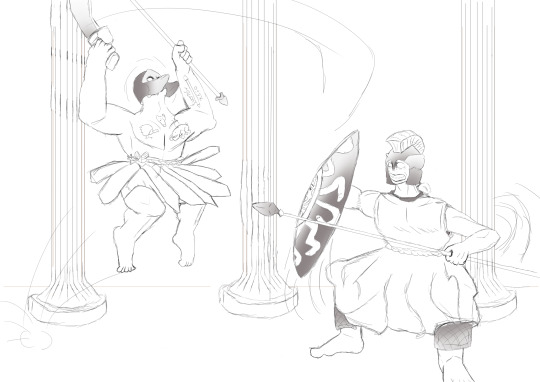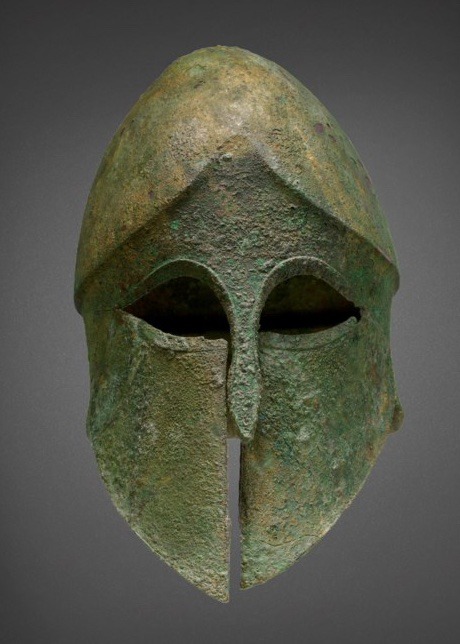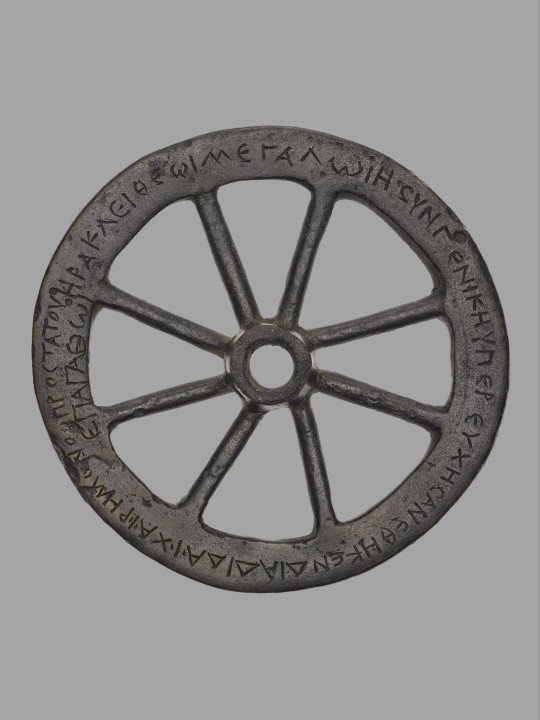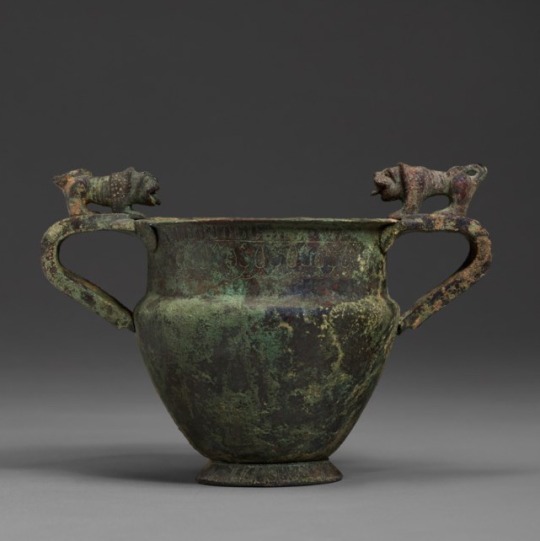#archaic greek
Text

Dumb guy vs. Smart Lady
#monochrome#fanart#beginner drawing#ares#athena#oc#ancient greek#archaic greek#violence deptiction#kopis#spear#aegis art#aegis#Ares' tattoo says “Spear Arm” roughly
2 notes
·
View notes
Text
youtube
My 2¢:
5:01 About that Greek letter Ε ε. Its original Ancient name was just εἶ eî (/eː/ or /ei/). From my understanding, its current name ἒ ψιλόν è psīlón (i.e. “simple e”) came about not because the Greeks stripped the letter from its /h/ but because in Middle Ages a need arose to distinguish it from the diphtong ΑΙ αι ai which came to be pronounced as /e/. Thus: Ε ε (e), i.e. “simple e” vs ΑΙ αι (ai), i.e. “diphthong e”.
As an aside, the analogous naming process was applied to the following Greek letters as well due to pronunciation changes:
Υ υ ὖ ŷ (/yː/) → ὖ ψιλόν ŷ psīlón (i.e. “simple y”) vs ΟΙ οι oi (i.e. “diphthong y”), because the latter came to be pronounced as the former (/y/),
Ω ω ὦ ô (/ɔː/) → ὦ μέγα ô méga (i.e. “big o”) vs Ο ο οὖ oû (/oː/ or /ou/) → ὂ μικρόν ò mikrón (i.e. “small o”), because the long vowel /ɔː/ that the letter Ω ω represented became shortened to /o/ &, thus, indistinguishable from the sound that was represented by the letter Ο ο.
5:50 The reason why the Greek Ρ ρ (ῥῶ rhô) & the Latin P p look similar. As far as I know, the right “leg” of Π π (πεῖ peî) came to be written progressively rounder & curvier until it became P p. The Latin R r got its bottom right “leg” probably as an easier way to connect it to a following letter. One way one could write the Greek Ρ ρ is to start at the middle point, go to the right, make a circle, & then make a descender. Or one could write it in the opposite way, thus ending at the middle point. It’s not difficult to imagine then that in rapid writing one would extend a line from that middle point of P onto the next letter—& that’s how you make that bottom righ “leg”, thus turning P into R.
13:25 What is also interesting about the letters G g & Z z is that Z z in the earliest Latin alphabet was placed betwixt F f & H h (i.e. in G’s place): ABCDEFZHIKLMNOPQRSTVX. Not unlike the Greek letter Ζ ζ (ζῆτα zē̂ta) which precedes Η η (ἦτα ē̂ta) and succeeds the now obsolete letter Ϝ ϝ (ϝαῦ waû or δίγαμμα dígamma). Later on, the Romans ditched the letter Z z due to not needing it to write their own words & replaced it with the newly-minted G g. However, the increasing number of Greek loanwords made it necessary to re-borrow the Z z back into the alphabet. It did not return to its former place in the alphabetical order but, instead, was appended to the end thereof (alonside Y y).
14:15 “It [i.e. the Phoenician letter 𐤎 (samekh)] took on two forms in the lands that now constitute Greece”. It is purported that the letter 𐤎 (samekh) developed into Ξ ξ (/ks/) & Χ χ (/kʰ/) in the Eastern Archaic Greek (& what would become the Standard Greek) alphabet. In the western part of Greece, however, only the Χ χ shape was used and its phonetic value was /ks/ (& in order to represent the /kʰ/ sound, digraph ΚΗ was used instead)—that’s how the Etruscans (then the Romans & the rest of the Western world) got the letter X x. In contrast, in languages that use Cyrillic-based alphabets the letter Х х stands for /h/ or /x/ (ch as in “Loch Ness”) because the Cyrillic script was derived from the eastern version of the Greek alphabet.
Interestingly enough, the voiceless velar fricative consonant is represented by the letter x in the International Phonetic Alphabet precisely because that’s the sound that is made by the Greek letter Χ χ in Modern Greek (not Ancient Greek though) and the Cyrillic letter Х х in many Slavic languages.
Indeed, one can say that the history of the alphabet has many plot twists.
1 note
·
View note
Text
welp, just thought the words "that maiden" in Old English and Archaic Greek (or something??? maybe this word is older????) at once and thought "seo kore". brb gonna yeet myself into the ocean/j
#is this the lowest or highest point yet of my study of linguistics#SEO KORE???? WHAT IS WRONG W ME#its CORRECT it just SHOULD NOT BE.#linguistics#academia#old english#archaic greek#classical greek#ancient greek#can u tell i know VERY LITTLE abt Greco-Roman/Mediterranean languages i just know a word here and there
1 note
·
View note
Text

Hand of a Kore holding a fruit, Attic workshop, 6th century BC, marble, Acropolis Museum, Athens.
4K notes
·
View notes
Text






A GREEK BRONZE CORINTHIAN HELMET
LATE ARCHAIC TO EARLY CLASSICAL PERIOD, CIRCA 525-475 B.C.
#A GREEK BRONZE CORINTHIAN HELMET#LATE ARCHAIC TO EARLY CLASSICAL PERIOD#CIRCA 525-475 B.C.#bronze#bronze helmet#military equipment#ancient artifacts#archeology#archeolgst#history#history news#ancient history#ancient culture#ancient civilizations#ancient greece#greek history
211 notes
·
View notes
Text

Relief from Selinunte, one of the Greek colonies in Sicily, 6th century BCE. Two deities on a chariot, perhaps Demeter and Persephone (Hera and Athena or Helios and Selene have also been suggested).
Photo taken from here. I cropped it a bit.
194 notes
·
View notes
Text

Archaic Medusa
Got tired of seeing Medusa designed as a generic pretty woman but with snake hair. Also made a little height chart.
#greek mythology#ancient greek mythology#greek pantheon#medusa#gorgon#perseus and andromeda#perseus and medusa#gorgons#archaic#greek mythology art#Athena#athena greek mythology
84 notes
·
View notes
Text
Key Details That I Would Require In An Accurate Movie About Greek Mythology
Both Aphrodite and Eros being nude in several scenes, but never acting modest or shameful about it. Not for sexualization, but because they are, oh I dunno... literal gods of lust?
Dionysus having extremely feminine facial features, because he was described as both masculine and feminine (being the god of gender confusion).
Athena with gray eyes, no explanation needed.
Ares being brutish, but not misogynistic. He was anything but misogynistic.
Athena and Ares always being clad in armor.
Artemis and Apollo having a sibling relationship, being nippy and snarky towards one another.
Kin of Helios having golden/yellow eyes, for accuracy.
#comment other details that you'd want#greek mythology#greek myth#mythology#author#greek mythos#ancient greece#archaic greece
130 notes
·
View notes
Text

A figure holding two tridents stands between horses. The scene has been interpreted as ritual horse-sacrifice, though this is not certain. Ancient Greek pottery fragment in the Geometric style, dating to the Archaic period (8th century BCE) and located in the Archaeological Museum of Argos. Photo credit: Zde/Wikimedia Commons.
#classics#tagamemnon#Ancient Greece#Archaic Greece#art#art history#ancient art#Greek art#Ancient Greek art#Archaic Greek art#Geometric period#pottery#potsherd#Greek religion#Ancient Greek religion#Hellenic polytheism#vase painting#Archaeological Museum of Argos
231 notes
·
View notes
Text
Fun fact: While reading the Homeric Greek prototype of the Iliad, I noticed Homer mentions numerous times the words μύες (muscles) and nerves (νεύρα), and many organs of the human body. The words not only are identical to the Modern Greek equivalents but also bear the exact contemporary anatomical meaning. There is also the mention of bones (οστά) of course, which is not as impressive since bones are easily comprehensible, but in my opinion the fact that apparently ancient Greeks of the early archaic period were aware of the nerves and their function more or less is very fascinating. There is often the mention of shearing or cutting muscles, tendons or nerves.
I searched a bit about in on the internet and found this:

From Hektoen International.

From PubMed, Anatomical references in Homer’s Iliad.
#greece#Homer#Iliad#Ancient Greece#Homeric epics#Homeric age#archaic period#greek language#greek culture#thoughts#random
141 notes
·
View notes
Text
I kept wondering why would Natalie be the Antler Queen's favorite, if Lottie's the most connected... Then, I remembered.
Lottie's the oracle of a God.
Natalie's the champion of a God.
#yellowjackets#lottie matthews#natalie scatorccio#yellowjackets fandom#yellowjackets thoughts 💭#diary pages#antler queen#the champion is the beloved one#but the champion also perishes in the end#yes i guess i was mostly thinking by greek mythology notions... blame the classical studies#i could even maybe talk about the envy of gods here... but no not really maybe not#no yj strikes more... like north european in extremely archaic nature worshipper times hunter gatherer society#AND the deer is the sacred animal...#mythology#folklore#no no the wilderness destroying natalie is a god destroying her beloved i already talked about it#yellowjackets text posts#yellowjackets analysis
26 notes
·
View notes
Text

▪︎ Votive bronze wheel inscribed with a dedication to Herakles.
Culture/Period: Archaic Greek
Date: 525-500 B.C.
Medium: Bronze
#ancient#ancient art#history#museum#archeology#ancient sculpture#archaeology#votive#bronze#wheel#inscribed#Herakles#archaic#greek#ancient greek#525 b.c.#500 b.c.
521 notes
·
View notes
Text
i love Tumblr Mythology and its spread. someone on Reddit just tried to assert that the oldest definitive version of the myth of Medusa is Ovid.
#m#bestie he wasnt even greek#they were trying to tell me how the ORIGINAL myth was her as a rape victim punished by athena#like yeah that's ovid's version#in archaic greece she was just a scary monster from the get go
890 notes
·
View notes
Text

Athena, Attic workshop, c. 500 BC, marble, Acropolis Museum, Athens.
#sculpture#art history#athena#greek mythology#ancient greece#ancient greek art#mythology#mythological art#athens#acropolis museum#statue#marble#archaic period
136 notes
·
View notes
Text

A GREEK BRONZE KANTHAROS
ARCHAIC PERIOD, CIRCA LATE 6TH-EARLY 5TH CENTURY B.C.
#A GREEK BRONZE KANTHAROS#ARCHAIC PERIOD#CIRCA LATE 6TH-EARLY 5TH CENTURY B.C.#ancient bronze#ancient artifacts#archeology#archeolgst#history#history news#ancient history#ancient culture#ancient civilizations#ancient greece#greek history#greek mythology#greek art
67 notes
·
View notes
Text
Trying to design period accurate costumes for Antigone for my Drama A level.
WHY DOES EVERY REFERENCE BOOK TREAT ANCIENT GREECE LIKE ONE COHESIVE WHOLE!?!?!!?!?!?!
Like, I know there's got to be a difference between what they would have worn in the Mycenaean age and what Sophocles-era classical greeks would have worn and Hellenistic Greeks would have worn and so on and so forth. Human beings won't be wearing the same thing without variation for over a thousand years. I know that from my other forays into fashion history.
Yet, nothing I can find is telling me about this difference, and I'll get the marks whether I can communicate the singularity of 400BCE fashions or not, but I want to KNOW so that the costumes can be RIGHT, rather than just tossing off the popular Greek silhouette.
The examiner probably won't care if there are archaic elements in there, but I would really rather do it right than counting on the examiner not being an expert in Classical Greek fashion history.
So, um, if anyone knows about the identifying features of what would have been worn by Athenian or Theban Greeks in the early 400s BCE, please please please help a very lost and confused child.
#fashion history#ancient history#ancient greece#homeric greece#archaic greece#classical greece#hellenistic greece#antigone#drama#all my books are just like oh yes here is this Ancient Greek and this is what their clothes are called#yes#but can you also tell me how it differs to what other ancient greeks wore?#no#I know nothing#and I know that I know nothing and its frustrating#please#if you know anything#fabrics#dyes#jewellry#hair#armour#literally anything#I am so lost#please help a poor lost child who just wants to KNOW
7 notes
·
View notes